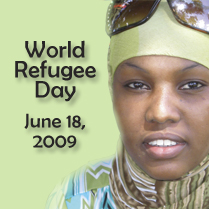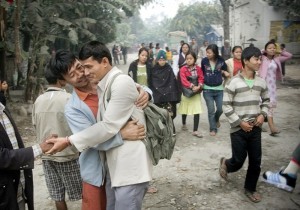Real People, Real Needs
Launching the annual report on refugee trends at Washington D.C on June 16, United Nations High Commissioner for Refugees Antonio Gutterres said that the amounts needed to rescue people are less than what is needed to rescue banks. The chief of the United Nations High Commissioner for Refugees (UNHCR) Gutterres strongly urged the aid agencies and international community not to allow the global economic crisis to deteriorate humanitarian aid. (Download his speech)
The 2008 Global Trends released by the UNHCR shows the number of people forcibly uprooted by conflict and persecution worldwide stood at 42 million at the end of December 2008. The total includes 16 million refugees and asylum seekers, and 26 million internally displaced peoples (IDP), uprooted within their territories. According to the UNHCR’s statistics, among recent displacement crises, up to 2 million people have been displaced from Pakistan alone last year mostly due to violence between the government and militant forces while about same number of refugees and IDPs were able to return home.
The US Committee for Refugees and Immigrants (USCR) figured that the major returns were from Pakistan to Afghanistan, Tanzania to Burundi and from various countries to Sudan among others. It is a bitter reality that one out of four refugees in the world is from Afghanistan and Afghans are located in 69 different asylum countries. The World Refugee Survey 2009 published by the USCR mentioned that every year hundreds of thousands of refugees return to their home countries, but not always voluntarily. In some cases, fundamental changes in their home countries end the dangers that have forced them to flee and overtly forcible return remain rare. The survey highlighted that many refugees, however, suffer insecurity, threats of refoulement, detention, and decades of enforced idleness and restrictions on movement and normal life in countries of asylum, casting doubt on whether their return is truly voluntary.
In 2008, the UNHCR provided direct cares for 10.5 million refugees. According to the USCR around 13.5 million people, either refugees or IDPs, are dependent on aid offered by donor agencies. How do the UNHCR and other refugee aid agencies generate funds for assisting such a large number of refugees and IDPs? This may severely strike your brain. There are some regular and potential donors for making such funds available. Among the top 20 donors in 2008, ranked by various refugee-concerned organizations, the United States of America stood first making a direct cash donation of $ 606 million. Other major donors in 2008 were European Commission ($ 307 million), Sweden ($ 157 million), Japan ($ 125.7 million) and The Netherlands ($ 116.8 million).
It may be surprising to read here that among the top 20 countries donating for refugees’ food and shelter, Luxembourg stood first in 2008. The per capita contribution made by Luxembourg last year was $ 30.12. The United Nations in 2003 placed Luxembourg having population of 453,000 as number 163 in population among the 193 nations of the world. Bhutan, having population less than 6 million, is the only country in the world which has nearly one-third of its population as refugees in exile. (Download UNHCR Fact Sheet on Bhutanese Refugees)
Similarly, the ratio between refugees and population in West Bank and Gaza figures 1:2. The UNHCR has reported that Pakistan hosts the largest number of refugees worldwide (1.8 million), followed by the Syrian Arab Republic (1.1 million) and the Islamic Republic of Iran (980,000). Palestinians refugees have been taking refuge in West Bank and Lebanon for the last 60 years. Even in Nepal, Tibetan refugees have been dwelling since 50 years.
The 1951 Refugee Convention relating to the Status of Refugees does not require any country to bring refugees to its shores. Many countries, especially those having better mechanisms for protecting refugees and IDPs bring refugees for resettlement when other integral options like repatriation and local integration remain impossible. The experience of the USCR, which has been serving refugees for over 50 years, reveals that many do or accept a quota of the UNHCR’s referrals of refugees with particularly compelling needs for protection. Traditionally, wealthy countries with strong immigration histories have accepted the largest numbers of refugees for resettlement. The USA alone resettled 60,191 refugees last year. Canada and Australia stood at the second and the third rank accepting 10,804 and 8,742 refugees from various countries including the exiled Bhutanese from Nepal.
For years, many countries and regions have been observing their own refugee days and even weeks. However, the UN General Assembly adopted Resolution 55/76 on 4 December 2000 to celebrate June 20 as World Refugee Day with a different theme every year. Finally, a quote from the UNHCR’s website is worthy of mentioning here – the UNHCR for this year, with the world economic crisis threatening to slash aid budgets and amid enormous global uncertainty, we need to ensure refugees are not forgotten and that is why the theme for this year’s World Refugee Day is Real People, Real Needs.


